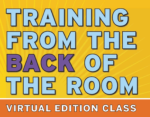4 Differences Between the Virtual and In-Person TBR Classes
 The questions have come up many times: “What are the differences between the ‘Training from the BACK of the Room’ Virtual Edition (TBR-VE™) Class and the in-person TBR Practitioner Class? Are the classes interchangeable? Does one class replace the other?”
The questions have come up many times: “What are the differences between the ‘Training from the BACK of the Room’ Virtual Edition (TBR-VE™) Class and the in-person TBR Practitioner Class? Are the classes interchangeable? Does one class replace the other?”
Here are 4 major differences between the TBR-VE™ Class and the in-person TBR Practitioner Class:
1. Different Purposes: This is the most obvious. The purpose of the 2-day, in-person TBR Practitioner Class is to give corporate trainers and classroom teachers the skills they need to facilitate highly-interactive, brain-based learning experiences in a face-to-face learning environment.
The purpose of the 5-module (2.5 hours per module), TBR-Virtual Edition (TBR-VE™) Class is to do the same in a live-streaming, virtual learning environment. The two environments require different class structures, different skill sets on the part of the trainer, and different learning behaviors on the part of the class participants.
 2. Different Audiences: The in-person, 2-day TBR Practitioner Class is designed for participants who are actively teaching/training/instructing others in face-to-face learning environments. The TBR-VE™ Class is designed for anyone instructing others in live-streaming, virtual environments.
2. Different Audiences: The in-person, 2-day TBR Practitioner Class is designed for participants who are actively teaching/training/instructing others in face-to-face learning environments. The TBR-VE™ Class is designed for anyone instructing others in live-streaming, virtual environments.
Is there an overlap of concepts/strategies in both classes? Of course there is – both classes are based on how the human brain learns best (and the scientific research that supports learner-centered, brain-based instruction). With that said, the current research points out significant differences between successful in-person instruction and successful virtual instruction.
 3. Different Structures: The two classes are totally different in the ways they are structured. The in-person class is presented in 2 back-to-back days, primarily because that saves companies and educational institutions time and money. Most organizations cannot afford releasing employees to attend classes that span a longer time-frame (i.e. 3 or more days of instruction delivered over 1 – 2 weeks or more).
3. Different Structures: The two classes are totally different in the ways they are structured. The in-person class is presented in 2 back-to-back days, primarily because that saves companies and educational institutions time and money. Most organizations cannot afford releasing employees to attend classes that span a longer time-frame (i.e. 3 or more days of instruction delivered over 1 – 2 weeks or more).
In contrast, the virtual class is designed the way that brain research indicates is best for long-term learning: shorter instructional “modules” (i.e. class segments) with “spaced practice” in between each module. So the virtual class spans about 2 1/2 – 3 weeks. The virtual class also allows for a “flipped classroom” approach to instruction, where some of the “lecture segments” are taught offline via videos, slide presentations, and articles. The majority of the online segments are concrete practice activities, using both live-streaming and digital whiteboard strategies.
For a more comprehensive look at the optimum structure for a virtual class (as opposed to an in-person class), please read “When Everything is Suddenly Virtual” by TBR Certified Trainers Jean-Paul Bayley and José Casal.
4. Different Skill Sets: When instructing in a face-to-face setting, “platform skills” (i.e. a trainer’s body language, movement, voice tone, and facial expressions) are important, but they play a lesser role to that of learner-interaction. If learners are engaged in collaborative, relevant activities, the lack of platform skills on the part of the trainer does not significantly lessen the learning experience.

The same cannot be said for virtual instruction. “Staging” is what platform skills are called in the virtual world. Staging includes the trainer’s skills in using digital technology that can make or break a virtual learning experience. Besides body/voice skills, a virtual instructor’s tech skills include professional lighting, camera, audio equipment, background, and more. For a detailed list of staging skills, see “6 Staging Tips for Facilitating a Virtual Class.”
The cognitive load for participants of a virtual class is heavier than in-person classes; it takes more physical energy and mental concentration to pay attention to the content delivery AND digital technology at the same time. So participants have to learn a new set of behaviors that include lessening cognitive overload as well as learning the digital technology that will enable them to become successful in a virtual learning environment. For more details regarding the skills virtual learners need, read: “Take Charge of Your Learning! 9 Tips for Adult Virtual Learners.”
In Conclusion: Do you want to become an outstanding instructor in a virtual learning environment? If yes, the TBR-VE™ Class is for you. Do you want to become an outstanding teacher/trainer in a face-to-face learning environment? If yes, then consider attending an in-person, 2-day TBR Practitioner Class when these classes resume.
 Until Covid restrictions are lifted in many countries, your only choice at this time might be the TBR-VE™ Class. Here are a few final questions with my answers – hopefully, these will be helpful for your own learning journey:
Until Covid restrictions are lifted in many countries, your only choice at this time might be the TBR-VE™ Class. Here are a few final questions with my answers – hopefully, these will be helpful for your own learning journey:
1. Will the TBR-VE™ Class give you the best of the “Training from the BACK of the Room” concepts and strategies for a virtual learning environment? Absolutely!
2. Can you attend an in-person TBR Practitioner Class in the future, even after attending the virtual class? Of course you can.
3. Will the virtual class replace the in-person class prerequisite for attending a future Trainer Certification Course? Not at this time.
4. Will you be able to teach the TBR-VE™ Class once you attend this class? No, the TBR-VE Class is not a certification course. However, you will receive a Certificate of Completion and you will be invited to join the TBR-Practitioner Group on Slack where you will meet a global group of TBR practitioners. Also, you will be able to use what you’ve learned from the TBR-VE™Class to design your own virtual classes with your own training topics.
For descriptions of both the TBR-VE™ Class and the in-person TBR Practitioner Class, click HERE. For the public training calendar, click HERE. Stay safe on your learning journey! 🙂 Sharon
Hi Brando: Hopefully, we will be able to offer the TBR-VE Class in Spanish in the summer/fall of 2021. One of the Certified Trainers will be working on translating the class into Spanish. Saludos! Sharon
Hi! Do you offer the TBR -VE course in Spanish? Thanks